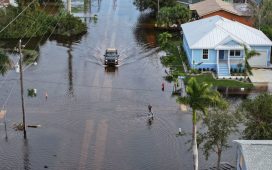The detailed distribution functions of flight arrival delay time are shown in Fig. 2. It can be seen that the distributions of flight delays are obviously different during SWEs. Compared to the QTPs, the delay time are obviously larger during SWEs. Particularly, the two delay distributions intersect near -10–0 min, and the probability density of positive delays during SWEs is always larger than the QTPs. In addition, the inner panel illustrates the delay time differences between the cumulative distribution functions of SWEs and QTPs. It is noted that the SEPs show the maximum deviation while the CMEs are the least evident. Correspondingly, the two sample Kolmogorov–Smirnov tests on the QTPs and the three SWEs are carried out, and the deduced critical values reject the null hypothesis, which indicates that the differences of flight delay time between QTPs and SWEs are significant but not due to chance alone.
To clearly quantify the flight delays during SWEs, the arrival delays together with their increments relative to those during QTPs are listed in Table 1. It is found that the average arrival delay time during SWEs is substantially increased by 81.34% compared with those during QTPs (from 9.11 min to 16.52 min). The 30-min arrival delay rate increases from 17.76 to 21.57%, while the long-term (≥ 240-min) delay rate increases by 47.59% during SWEs. It is noteworthy that the relative increment of delay time is remarkably higher than the delay rate. Moreover, both the largest delay time and the highest delay rate indicate that the most significant flight delays tend to occur during SEPs.
For the first time, the flight delays during SWEs are quantitatively investigated. However, the internal relationship between SWEs and flight delays has never been studied thoroughly. As stated in the introduction section, previous researchers have suggested that SWEs could have many negative effects on high-tech systems on Earth7,11,12,13,16,19,22. Among these various harmful effects, and taking the reality of the aviation industry into consideration, we propose that the impacts of SWEs on communication and navigation should be given the most attention.
Communication and navigation form the key functions in modern air traffic management, and they are cornerstones that ensure the safety and efficiency in air traffic. If the communication between Air Traffic Control (ATC) and the flight crew is disrupted, it would take ATC more time to issue operations to the pilot and the flight crew may also take additional time to confirm. In some cases, ATC may not be able to issue a clearance for takeoff or landing in a timely manner. In addition, if there is a communication breakdown, the dispatch center may not normally receive the up-to-date flight information, which could lead to incorrect flight planning and other errors. Hence, communication disruptions can have a significant impact on the smooth operations of the aviation system and cause a chain reaction of delays. Any slight delays in each stage may accumulate and lead to the obvious flight delays or cancelations. Similarly, navigation malfunctions may also result in flight delays, since aircraft may need to be rerouted, held on the ground, or undergo additional inspections until the navigation system is functional. CAAC mandatorily requires aircraft must maintain two-way communication with ATC at all times while flying to hub airports25. Moreover, aircraft must be equipped with at least two independent navigation devices, such as Global Navigation Satellite System (GNSS) and the very high frequency omnirange station (VOR)26. Particularly, if the communication is breakdown during magnetic storm, ATC may temporarily stop aircraft taking off or advise aircraft to land at the nearby airport27. Therefore, either the degradation or interruption of communication or navigation, whether on the air routes or near the airports can contribute to flight delays. While malfunctions of communication and navigation system could be directly attributed to the geomagnetic field fluctuations and ionospheric disturbances driven by SWEs5,6,9,28.
Analyzing the Dst data, foF2 data and TEC data are common research methods for quantifying the disturbances in geomagnetic field and ionosphere8,29,30. The Dst index could represent the change of the horizontal component of the Earth’s magnetic field, and the sudden change in Dst is a characteristic of geomagnetic storm31. During geomagnetic storms, the violent changes in magnetic fields could induce destructive currents that might disrupt the electric-power systems on the ground. Moreover, the geomagnetic storm could trigger ionospheric storm that greatly disturb the ionospheric environment3,4. The foF2 is very important in HF communications since the HF signal needs ionosphere for reflection over long distances. The radio signal would be absorbed excessively and its propagation path could become unexpectedly when the foF2 is disturbed, so the communication quality would be degraded or even interrupted during ionospheric disturbances. To evaluate such effects, the deviation of the monthly median of foF2 (∆foF2) is introduced to quantify the normal fluctuations of the ionosphere relative to its undisturbed status. In that case, ∆foF2 could also be used to evaluate the communication quality3,4,29. The Rate of TEC index (ROTI), defined as the standard deviation of the rate of change of the TEC, is another useful indicator to describe the temporal ionospheric irregularities. Ionospheric irregularities are usually small-scale disturbances in the ionosphere that could lead to significant interferences of many satellite-related systems by rapidly modifying the amplitude and phase of a radio signal (ionospheric scintillation). Consequently, these disturbances in the ionosphere would also affect communication and navigation systems3,4,32. Therefore, to investigate the internal relationships between SWEs and flight delays, here we would consider the rate of change in Dst (dDst), ∆foF2 and ROTI as three most important indicators and try to reveal the impacts of geomagnetic field fluctuations and ionospheric disturbances on flight delays.
The time resolution of the Dst index is 1 h, so the dDst in a certain time (ti) is the absolute difference of the Dst in the adjacent two hours, dDstti =|Dstti − Dstti-1|. ∆foF2 is a dimensionless quantity, ∆foF2ti =|foF2ti−foF2med|/foF2med, where foF2med is the moving median of the nearby 28-day data. \({\mathrm{ROTI}}_{\mathrm{ti}}=\sqrt{<{\mathrm{ROT}}_{\mathrm{ti}}^{2}>-{<{\mathrm{ROT}}_{\mathrm{ti}}>}^{2}}\), where the < > denotes moving average during 1 h and ROTti = (TECti−TECti-1)/(ti − ti-1).
The geomagnetic field fluctuations and ionospheric disturbances indicated by dDst, ∆foF2 and ROTI, together with their relations to flight delays are shown in Fig. 3. It is found in Fig. 3(a) that when geomagnetic field is in a relative stable period (dDst < ~ 10 nT/h), both the delay time and delay rate increase slightly with dDst. As the fluctuations of geomagnetic field graduate to a more intense stage (especially dDst > ~ 20 nT/h), the flight delays also become obviously larger. Similar phenomena could be found in Fig. 3(b) and (c) that both the delay time and delay rate tend to show roughly positive relationships with ionospheric disturbances. In particular, no obvious delay increases are seen when ∆foF2 < 15%, while good monotonically increasing linear relationship between ∆foF2 and flight delays are found when ∆foF2 > 15%. As to the ROTI, it is found that the delay time and delay rate reveal sharp-gentle-sharp increases with ROTI, and the most prominent turning point is around 0.2 TECU/min. Regardless of dDst, ∆foF2 and ROTI, all the similar behaviors in flight delays indicate that the flight delays would not be substantially influenced by the magnetospheric–ionospheric disturbances when the disturbances is relatively small. However, when the disturbance exceeds a certain threshold (e.g., dDst > ~ 20 nT/h, ∆foF2 > 15% and ROTI > 0.2 TECU/min), the flight delays display conspicuous positive monotonic relationships with the degree of geomagnetic field fluctuations and ionospheric disturbances. Figure 3(d), (e) and (f) also show that the probability density of dDst, ∆foF2 and ROTI during SWEs are always higher on the right-hand side, which implies that the degree of geomagnetic field fluctuations and ionospheric disturbances is obviously larger during SWEs than those during QTPs. These results are consistent with previous studies8,9, and all these analyses indicated that more severe flight delays tend to occur when the magnetospheric–ionospheric disturbances are larger.
Eliminating various interference factors is quite important for deriving the statistically valid effects of SWEs on flight delays. Actually, although presented statistical work has avoid the daily periodicity of flight delays, the impacts of space weather on flight delays are still underestimated. First of all, the real impacts of SWEs on our Earth can persist far beyond 24 h. For example, the SWEs triggered geomagnetic storm can even last for 3–5 days, so a part of SWEs affected flights will be classified into QTPs. Such scenario can also be revealed in Fig. 3(d), (e) and (f). One can find that there still exists large value of dDst, ∆foF2 and ROTI during QTPs, though their probability density is relatively very low. In addition, both geomagnetic field fluctuations and ionospheric disturbances need time to respond to SWEs33. However, some SWE affected flights in current definitions, especially those at the beginning of a SWE, may not really be affected by SWEs. Therefore, in real situations, the SWEs should have more significant effects on flight delays, and the delay difference between SWEs and QTPs will be more prominent.
Certainly, using 48-h or 72-h duration to define SWEs can also avoid the flight’s daily periodicity. Nevertheless, selection of a longer duration would lead to overlapping events, since SFs, SEPs and CMEs often arrive on Earth successively. In presented analysis, the selection of 24-h duration of SWEs is an acceptable choice after deliberations that could both guarantee the independence of each event and achieve a reasonable result. While five out of eight investigated SEPs cannot yet be isolated since they arrive on Earth within 24 h after SFs. The five overlapped SWEs are kept in the analyses, otherwise the sample of SEPs will be too few. Even so, such overlapping will not alter the final conclusions of this paper. However, such overlapping could enhance the disturbance of the magnetosphere and ionosphere3,4,33. Accordingly, the associated compound effects of SWEs may partially explain why the SEPs affected flights have the most serious delays.
Flight delays are highly non-linear, complicated and interconnected phenomena, hence the research samples we chosen are from the five largest hub airports in China over five years, which are adequate to reveal the primary characteristics of flight delays. Moreover, although the contingencies that leading to flight delays have been smeared out to a considerable extent by the random distributions of SWEs and the usage of large amounts of flight data, we still intend to expand the research samples since longer research samples can also be conducive to reduce the impacts of various contingencies. Therefore, we also examine the 22-years’ (two solar cycles) national flight regularity rate data from 1998 to 2019. By analyzing the sunspot number and flight regularity rate data through entire two solar cycles, it is revealed that the yearly mean flight regularity rate was negatively correlated with the yearly mean total sunspot number. Sunspot number is an excellent indicator of solar activities, so a higher (lower) sunspot number means more (less) solar activities, and correspondingly, more (less) SWEs4. As shown in Fig. 4, one can find that if there are more SWEs occur in a year, the flight regularity rate will be found to be lower. While the flight regularity rate tends to be higher if there are less SWEs. These results not only suggest that the long-term flight regularity rate could be modulated by SWEs but also confirm our previous results. Such consistencies also indicate that the methods we used to eliminate the internal periodicities and contingencies of flight delays are statistically valid, and the ‘real’ effects of SWEs on flight delays are successfully revealed.














